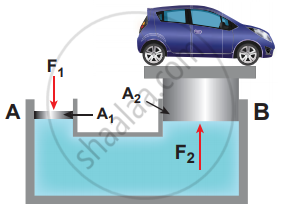Advertisements
Advertisements
Question
State and prove Pascal’s law in fluids.
Solution
Statement of Pascal’s law: If the pressure in a liquid is changed at a particular point, the change is transmitted to the entire liquid without being diminished in magnitude.

Hydraulic lift
Application of Pascal’s law:
Hydraulic lift: A practical application of Pascal’s law is the hydraulic lift which is used to lift a heavy load with a small force. It is a force Hydraulic lift multiplier. In consists of two cylinders, A and B connected to each other by a horizontal pipe, filled with a liquid. They are fitted with frictionless pistons of cross-sectional areas A1 and A2 (A2 > A1). Suppose a downward force F is applied on the smaller piston, the pressure of the liquid under this piston increases to `"P"("where", "P" = "F"_1/"A"_1)`. But according to Pascal’s law, this increased pressure P is transmitted undiminished in all directions. So pressure is exerted on piston B. Upward force on piston B is
`"F"_2 = "P" xx "A"_2 = "F"_1/"A"_1 xx "A"_2 ⇒ "F"_2 = "A"_2/"A"_1 xx "F"_1`
Therefore by changing the force on the smaller piston A, the force on the piston B has been increased by the factor `"A"_2/"A"_1` and this factor is called the mechanical advantage of the lift.
APPEARS IN
RELATED QUESTIONS
State Pascal’s law in fluids.
State Archimedes principle.
What do you mean by upthrust or buoyancy?
State the law of floatation.
Derive an equation for the total pressure at a depth ‘h’ below the liquid surface.
State and prove Archimedes principle.
We can cut vegetables easily with a sharp knife as compared to a blunt knife. Why?
